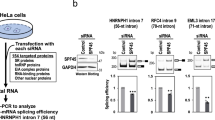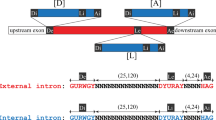Abstract
U2 small nuclear RNA is a highly conserved component of the eukaryotic cell nucleus involved in splicing messenger RNA precursors1–3. In the yeast Saccharomyces cerevisiae, U2 RNA interacts with the intron by RNA-RNA pairing between the conserved branchpoint sequence UACUAAC and conserved nucleotides near the 5' end of U2 (ref. 4). Metazoan U2 RNA is less than 200 nucleotides in length5, but yeast U2 RNA is 1,175 nucleotides long6. The 5' 110 nucleotides of yeast U2 are homologous to the 5' 100 nucleotides of metazoan U2 (ref. 6), and the very 3' end of yeast U2 bears a weak stuctural resemblance to features near the 3' end of metazoan U2. Internal sequences of yeast U2 share primary sequence homology with metazoan U4, US and U6 small nuclear RNA (ref. 6), and have regions of complementarity with yeast Ul (ref. 7). We have investigated the importance of the internal U2 sequences by their deletion. Yeast cells carrying a U2 allele lacking 958 nucleotides of internal U2 sequence produce a U2 small nuclear RNA similar in size to that found in other organisms. Cells carrying only the U2 deletion grow normally, have normal levels of spliced mRNA and do not accumulate unspliced precursor mRNA. We conclude that the internal sequences of yeast U2 carry no essential function. The extra RNA may have a non-essential function in efficient ribonucleoprotein assembly or RNA stability. Variation in amount of RNA in homologous stuctural RNAs has precedence in ribosomal RNA8,9 and RNaseP10.
This is a preview of subscription content, access via your institution
Access options
Subscribe to this journal
Receive 51 print issues and online access
$199.00 per year
only $3.90 per issue
Buy this article
- Purchase on Springer Link
- Instant access to full article PDF
Prices may be subject to local taxes which are calculated during checkout
Similar content being viewed by others
References
Green, M. A. Rev. Genet. 20, 671–708 (1986).
Sharp, P. Science 235, 766–771 (1987).
Maniatis, T. & Reed, R. Nature 325, 673–678 (1987).
Parker, R., Siliciano, P. & Guthrie, C. Cell 49, 229–239 (1987).
Reddy, R. Nucleic Acids Res. 14, suppl. r61–r72 (1986).
Ares, M. Cell 47, 49–59 (1986).
Kretzner, L., Rymond, B. & Rosbash, R. Cell 50, 593–602 (1987).
Woese, C., Gutell, R., Gupta, R. & Noller, H. Microbiol. Rev. 47, 621–669 (1983).
Clark, C., Tague, B., Ware, V. & Gerbi, S. Nucleic Acids Res. 12, 6197–6220 (1984).
James, B., Olsen, G., Liu, J. & Pace, N. Cell 52, 19–26 (1988).
Siliciano, P., Jones, M. & Guthrie, C. Science 237, 1484–1487 (1987).
Patterson, B. & Guthrie, C. Cell 49, 613–624 (1987).
Siliciano, P., Brow, D., Roiha, H. & Guthrie, C. Cell 50, 585–592 (1987).
Ares, M. & Igel, A. in Molecular Biology of RNA UCLA Symposium on Molecular and Cellular Biology Vol. 94 (ed. Cech, T.) (Liss, New York, in the press).
Fitzgerald-Hayes, M., Clarke, L. & Carbon, J. Cell 29, 235–244 (1982).
Gallwitz, D. & Sures, I. Proc. natn. Acad. Sci. U.S.A. 77, 2546–2550 (1980).
Ng, R. & Abelson, J. Proc. natn. Acad. Sci. U.S.A. 77, 3912–3916 (1980).
Miller, A. EMBO J. 3, 1061–1065 (1984).
Pleij, C., Rietveld, K. & Bosch, L. Nucleic Acids Res. 13, 1717–1731 (1985).
Tschudi, C., Richards, F. & Ullu, E. Nucleic Acids Res. 14, 8893–8903 (1986).
Maniatis, T., Fritsch, E. & Sambrook, J. Molecular Cloning: a Laboratory Manual (Cold Spring Harbor Laboratory, New York, 1982).
Riedel, N., Wise, J., Swerdlow, H., Mak, A. & Guthrie, C. Proc. natn. Acad. Sci. U.S.A. 83, 8097–8101 (1986).
Sanger, F., Nicklen, S. & Coulson, A. Proc. natn. Acad. Sci. U.S.A. 74, 5463–5466 (1977).
Boeke, J., LaCroute, F. & Fink, G. Molec. Gen. Genet. 197, 345–346 (1984).
Lustig, A., Lin, R.-J. & Abelson, J. Cell 47, 953–963 (1986).
Rothstein, R. Meth. Enzym. 101, 202–211 (1983).
Author information
Authors and Affiliations
Rights and permissions
About this article
Cite this article
Igel, A., Ares, M. Internal sequences that distinguish yeast from metazoan U2 snRNA are unnecessary for pre-mRNA splicing. Nature 334, 450–453 (1988). https://doi.org/10.1038/334450a0
Received:
Accepted:
Published:
Issue Date:
DOI: https://doi.org/10.1038/334450a0
This article is cited by
-
Structure and assembly of the SF3a splicing factor complex of U2 snRNP
The EMBO Journal (2012)
-
Human U2 snRNA can function in pre-mRNA splicing in yeast
Nature (1990)
-
Major determinants of the specificity of interaction between small nuclear ribonucleoproteins U1A and U2B" and their cognate RNAs
Nature (1990)
-
The post-RNA world
Nature (1988)
Comments
By submitting a comment you agree to abide by our Terms and Community Guidelines. If you find something abusive or that does not comply with our terms or guidelines please flag it as inappropriate.



